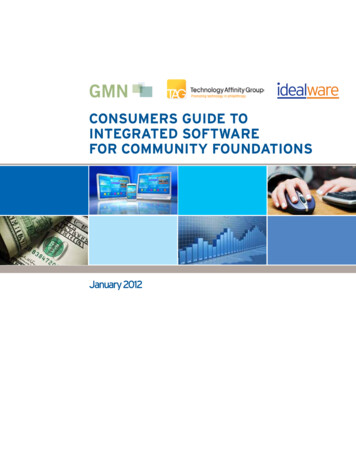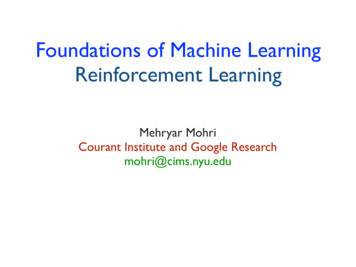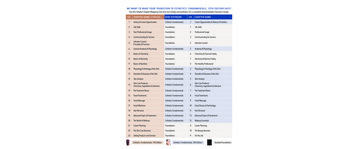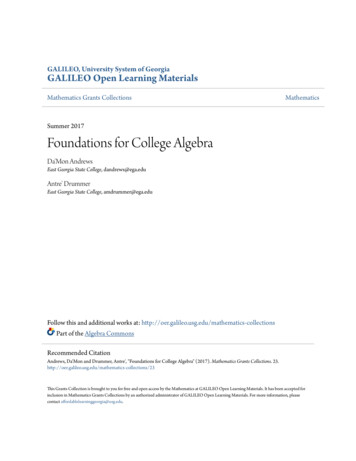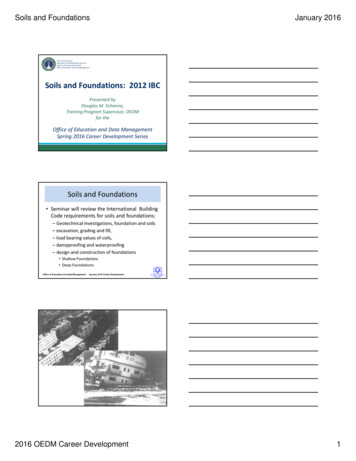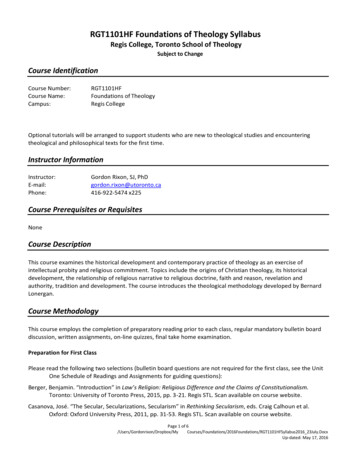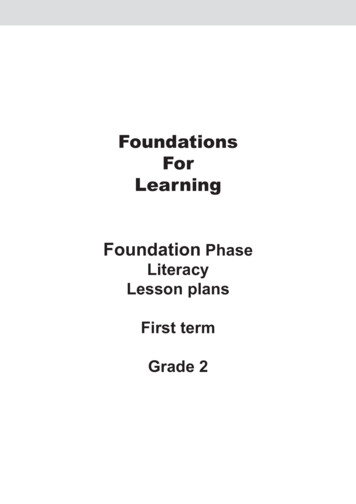
Transcription
FoundationsForLearningFoundation PhaseLiteracyLesson plansFirst termGrade 2
Kindly send any response that you may have to:Dr Jennifer J JoshuaE-mail: joshua.j@doe.gov.zaDepartment of EducationSol Plaatje House123 Schoeman StreetPretoriaSouth AfricaPrivate Bag X895Pretoria0001Tel: 27 12 312 6220Fax: 27 12 312 6222www.education.gov.za Department of EducationDesign and layout: Shereno (012) 344 2817FOUNDATION PHASE2LAYING SOLID FOUNDATIONS FOR LEARNING
Grade 2 LITERACY: First Term Lesson PlanTable of Contents1 Introduction.42 Literacy (Home Language) .9 Oral / Listening and Speaking.9 Phonics / Handwriting.9 Reading.10 Writing.13 Homework.14 Use of Themes / Contexts.14 Resources.14 Group Teaching / Group Work.153 First Term Overview of Lesson Plans.17 Overview of Assessment Tasks.19 Lesson Plans Week 1: Overview.21 Week 1: Lesson plans.22 Week 2: Overview.33 Week 2: Lesson plans.34 Overview of Assessment Task 1.40 Week 3: Overview.41 Week 3: Lesson plans.42 Week 4: Overview.49 Week 4: Lesson plans.50 Overview of Assessment Task 2.57 Week 5: Overview.59 Week 5: Lesson plans.60 Week 6: Overview.67 Week 6: Lesson plans.68 Overview of Assessment Task 3.74 Week 7: Overview.75 Week 7: Lesson plans.76 Week 8: Overview.83 Week 8: Lesson plans.84 Overview of Assessment Task 4.89 Week 9: Overview.91 Week 9: Lesson plans.92 Week 10: Overview.99 Week 10: Lesson plans.1004.Annexures Annexure 1: An example of one day’s Literacy lesson.108 Annexure 2: An example of a Phonics Plan for Grade 2.110 Annexure 3: List of 100 Most Common High Frequency Words.1113
INTRODUCTIONBACKGROUNDThe Foundations for Learning Assessment Framework which was distributed to all schools during2008 contained “milestones” for each grade. These milestones explain the content (knowledge,concepts and skills) embedded in the Learning Outcomes and Assessment Standards of the NCS,and indicate the expected level of achievement of learners at the end of each term. This documentcontains Lesson Plans based on the milestones.How do these Lesson Plans link to the Curriculumand the Foundations for Learning Campaign?These Lesson Plans have been developed using: The NCS Learning Outcomes and Assessment Standards as the starting point The Milestones and Government Gazette 30880 of 14 March 2008, which outlines the Foundations for LearningCampaign, details the minimum expectations for the teaching of Literacy and Numeracy(Languages and Mathematics) as well as providing timetabling and resourcing suggestions.The following table provides an example of how these three documents are linked for Grade 2Literacy (Home Language):Learning OutcomesMilestonesfor LiteracyGrades 1- 3LO 1 ListeningLO 2 Speaking LO 3 Reading andViewingLO 5 Thinking andReasoningLO 6 Language Structureand Usage LO 4 WritingLO 5 Thinking andReasoningLO 6 Language Structureand Usage FOUNDATION t Gazette: Daily TeacherActivities for Literacy Grade 2Grade 2 timeallocation inGazette Oral work at the beginning of the day10 min daily Listening and Speaking10 min twice aweek Shared reading or shared writingWord and sentence level workGroup, guided and independentreading/writingReading andWriting Focustime: 1 hourdaily Shared reading or shared writingWord and sentence level workGroup, guided and riting:10 min twice aweekWriting: 20min threetimes a weekLAYING SOLID FOUNDATIONS FOR LEARNING
Grade 2 LITERACY: First Term Lesson PlanHow do I use the time allocated for Literacy?The Government Gazette No 30880 provides the following breakdown of the formal teachingallocations for Numeracy and Literacy in the Foundation Phase per day:GradeDaily total orNumeracyDaily lLanguageLiteracyGrade 11 hour 30 minutes1 hour 50 minutes1 hour 40 minutes10 minutesGrade 21 hour 30 minutes1 hour 50 minutes1 hour 30 minutes20 minutesGrade 31 hour 45 minutes2 hours1 hour 30 minutes30 minutesAllowanceshould bemade forreading forenjoyment for30 minutes perdayThe Gazette further guides teachers by detailing the different aspects of language that should becontained in the Daily Teacher Activities, together with a time allocation.Government Gazette:Daily Teacher Activities for Literacy Grade 2Daily TimeAllocation inGazetteWeekly TimeAllocation inGazette Oral work at the beginning of the day.10 min per day50 min per week Listening and Speaking10 min twice aweek20 min per week Reading and Writing Focus Time:60 min per day :5 hours per weekoooShared reading or shared writingWord and sentence level workGroup, guided and independent reading/writing.ooo15 min15 min30 min Handwriting10 min twice aweek20 min per week Writing20 min three timesa week60 min per week Reading for Enjoyment30 min per dayHowever in practice: Because language activities are closely linked, certain activities often go together, for example,during the Reading and Writing time while some learners are busy doing writing, the teacher is5
doing group reading. Similarly, although there is a focused time for Oral, Listening and Speakinglearners will also be developing these skills during Reading and Writing. Activities can be “chunked” so that, for example, instead of 5 X 10 minutes per day for Oral youmay want to combine two of the days so that you have a 20 minute lesson on a Monday. It is unnecessary to “teach to the clock” and stick rigidly to the times on a daily basis. On somedays for example you may want to spend longer on a Shared Reading activity and less timeon Phonics. On another day you might shorten the written activities in favour of a longer Oralsession. However over the week you should try to balance the times to cover the allocations. Activities can be done in a different order. For example, Phonics can be linked with Handwritingand may often take place before the Shared Reading time. However it’s good to also vary thelessons. Look for opportunities to integrate both within Literacy and across the other two LearningProgrammes. A number of the activities can be linked to a theme / context so there are manyoverlaps with the other Learning Programmes. Integration takes place naturally.How, then can these lesson plans help teachers?What do they provide?These Lesson Plans are intended to assist teachers to pace their teaching, give them guidancewhen planning their assessment tasks and provide suggestions to enrich teaching practice. If youfollow these lessons systematically you will cover the curriculum and reach the milestones forGrade 2.However they are not intended to be prescriptive and teachers are not expected to abandongood practice in order to blindly follow the Plans.The Plans provide: An overview of the term, together with an Assessment Overview, broken into weekly units.The overview covers 10 weeks of work and provides a useful termly checklist. (You mightwant to compare this with your Work Schedule and your Phase Learning Programme and askyourself questions such as: Does your Work Schedule include similar content? Do you reachapproximately the same point at the end of each term? How does this compare to your AssessmentPlan?) .FOUNDATION PHASE6LAYING SOLID FOUNDATIONS FOR LEARNING
Grade 2 LITERACY: First Term Lesson Plan An overview for each week This helps you to see the content included in the week’s lessonplans, to see how it is paced and to make use of specific lesson plans. Learning Outcomes andAssessment Standards have been included. The latter have been numbered as AS1, 2, 3 etc. Nosub-bullets are indicated. Individual lesson plans for each week There are 10 weekly Lesson Plans for each term. Eachweek’s Plan provides Daily Activities for the different components in Literacy, correspondingto the milestones. These are. Oral Listening and Speaking Phonics Handwriting, Reading Writing.The lessons for the week are broken down into daily steps providing teachers with a breakdownof content and suggestions for implementation. However the Plans are not prescriptive and allowyou to use your own way of presenting the lesson. They are rich in practical ideas drawn fromBest Practice and as such can enrich implementation in the classroom. Suggestions for the Assessment Tasks for each term for each of the components are shownat the end of Week 2 (Assessment Task 1), Week 4 (Assessment Task 2), Week 6 (AssessmentTask 3) and Week 8 (Assessment Task 4).ADAPTING THE LESSON PLANSRemember: Every class and learner is unique. There can be no “one size fits all”. Learners progressat different speeds and learn in different ways and you, as the class teacher, are best able to paceyour teaching to the needs of your learners. You can introduce new material in another orderas long as you reach all the milestones for Grade 2. For example in Phonics the Lesson Plansprovide ONE order for the introduction of new sounds. But you are free to follow your own sequenceas long as it is systematic and thorough.7
How do teachers marry the activities in the Learner’sBooks and their own material with these Lesson Plans?Do the Lesson Plans replace the Learner’s Booksand Teacher’s Guides?These Lesson Plans should be used together with approved Teacher’s Guides, Learner’s Booksand Reading Books, They are not intended to replace the Teacher’s Guides and Learner’s Booksor the material you have developed yourself. The Lesson Plans do not provide actual worksheets,workcards or reading material for learners:Approved Teacher’s Guides should pace the work for the year so that all the Learning Outcomesand Assessment Standards are covered. There will therefore be similarities between the Teacher’sGuides and Learner’s Books and these Lesson Plans. However the order of content may be presentedsomewhat differently so you will need to compare and marry the content. Remember that ultimatelyyou are the decision maker.FOUNDATION PHASE8LAYING SOLID FOUNDATIONS FOR LEARNING
Grade 2 LITERACY: First Term Lesson PlanLITERACY (HOME LANGUAGE)This section explains the key points of each component of Literacy.ORAL / LISTENING AND SPEAKINGLearners enter Grade 2 able to speak their home language and possessing knowledge derived fromtheir home environment. However because home environments differ the knowledge learners bringto school also differs. The Oral / Listening and Speaking time provides a good opportunity to accessthis prior knowledge and link it to “school knowledge”.The attention span of young learners is short. Rather than one long weekly lesson many teachersstart most days with a brief oral activity with learners sitting on the carpet/floor. During this timeyou can: Talk about the day, date, the weather chart, learners who have birthdays and any specialhappenings for the day. Hear a few learners share their news / show and tell about a picture or object; (try to hear everylearner’s news at least once every two weeks). For the first few weeks, until learners start tocompose their own news, one of the learner’s news can be written as a short sentence on theboard. This is a valuable opportunity to revise individual letter sounds, explain how letters formwords / separate words make a sentence, the spacing between words, punctuation, spelling etc.It can also be a tool for the teaching of reading. On some days of the week learners can copy andillustrate this news.Being able to listen effectively is a key to learning which explains why it is a Learning Outcome onits own. However, unlike speaking, most learners’ listening skills are not well developed and specificattention needs to be given throughout the Foundation Phase to improve their listening skills. TheOral / Listening and Speaking component includes ideas for focused Listening Activities.PHONICS / HANDWRITINGPhonics and handwriting have been linked as the revision of the letter sound and how to writeit go together. The Term 1 lesson plans are structured so that on a particular day the same letter isrevised in phonics as in handwriting. This helps learners to link the sound of the letter to its visualform. Teachers have different views on the order in which to revise the sounds. No specific sequenceis recommended. It will depend upon the language and the teacher’s preference. However it makessense to revise the more frequently used sounds first. Teachers should also bear in mind letterformation so that, for example, one might choose to revise the letter c before a and the letter l beforeh and b. These Lesson Plans include one order of revising the sounds – but teachers should use theorder that they find most effective for them.The Lesson Plans suggest that the whole of the first term be spent on revising the sounds taught inGrade 1 - one single sound daily for the first six weeks, and then some common vowel and consonant9
diagraphs for the remainder of the term. Terms Two, Three and Four should be spent on teachingnew consonant and vowel blends and more complex sound patterns (as per the milestones).Handwriting means the legible formation of letters, words and numerals. It is essential that learnersmaster the skills of handwriting, because although handwriting may be supplemented by technicalaids such as the computer, it can never be replaced completely. Handwriting is a skill of fine motorcontrol and can only be learnt by continual practice. Although learners will develop their own writingstyles in later years, it is essential that they use the correct pencil grip, and are taught how to form theletters, the starting point, size, shape, direction of movement and how the letters are positioned on/spaced between the lines. Although all the upper and lower case letters have been taught in Grade1, revision is essential in Grade 2, particularly during the first term.Young learners often find difficulty in copying from the blackboard as their eyes need time to refocusfrom the board to the page in front of them and their short-term visual memory may not be welldeveloped. It helps to give learners writing strips containing a row of letters for the learners to copyduring Handwriting.READINGAlthough Reading and Writing are indicated as separate components they are closely linked. We“write to read and read to write”. The National Department of Education’s Teacher’s Handbook,‘Teaching Reading in the Early Grades’, provides details of the Reading and Writing Focus Time,explaining how learners will be involved with written tasks at the same time as the teacher is workingwith different reading groups.To learn to read learners need (a) skills to decode/make meaning of words, and (b) plenty ofpractice.How do I teach my learners to decode words?There are many approaches to the teaching of reading. Most teachers use a combination thatfocuses mainly on the following: the phonics approach - based on teaching learners to use sounds to decode words the ‘whole word’ or ‘look and say’ approach based on the principle of recognizing an individualword “on sight” through the use of continued repetition of a word . Words that appear frequently intext (High frequency words) can be learnt in this way. (English, unlike many languages, containsa large percentage of irregular words ie words that are not spelt as they sound.)FOUNDATION PHASE10LAYING SOLID FOUNDATIONS FOR LEARNING
Grade 2 LITERACY: First Term Lesson PlanHowever there are many other approaches that, if used wisely, can enhance learners’ ability to read.These approaches include: the language experience approach the sentence approach the story approach the psycholinguistic approachUsing an eclectic approach means that you choose a variety of approaches that complement oneanother. This approach will cater for the needs of all your learners. During Group, Guided Readingtime for example you can teach learners other word attack skills such as: reading to the end of the sentence rereading the sentence or using the pictureThese strategies help learners to use their understanding of the rest of the sentence, their knowledgeof grammar or the context to ‘predict’ the meaning of unknown words.How do I give my learners sufficient practice in reading?No one can become a fluent reader by reading for only a few minutes a day. We learn to read byreading. You need to use several different ways to get learners to read during the school day. Thesecan include a combination of Shared Reading (reading as a class), Group Guided Reading, PairedReading and Independent Reading. All of these are included in the Lesson Plans.Shared ReadingIn a Shared Reading lesson the teacher reads with the class or a group, using a large book thathas big print. (These texts can be obtained commercially or can be made by the teacher usingsheets of flipchart paper or even written onto the board.) The teacher introduces and models readingthe text and then re-reads the book with the learners reading along with the teacher. There areplenty of opportunities to develop reading skills, eg you can discuss the story and the illustrations,make predictions, develop listening and comprehension skills and increase vocabulary. The storycan become the starting point for a number of activities lasting several weeks. (Note: Textbooksor multiple copies of texts eg photocopies of texts you have written, can also be used for sharedreading, as long as every learner is looking at the same text.)11
Group, Guided ReadingLearners need to read texts that suit their level of competence (not too simple/not too difficult). Theyare not all ready to read the same texts at the same time. This is where group reading comes in.Learners can be grouped according to their reading ability, into 4 - 5 groups, with the teacher workingwith each group at least twice a week (at least three times a week with weaker groups, if possible).Group reading does not require any special readers. Although there are group reading schemes onthe market a variety of different readers can be used, even a single, longer reader. Working with asmall group, the teacher is able to revise words and sounds already taught, listen to the learnersread either individually or together, discuss the text and ask questions to check comprehension,model new reading strategies and teach new words. Weaker groups can work more slowly and getmore support from the teacher.Independent ReadingProviding opportunities for learners to read books on their own also develops fluency, provided thatthe books are easy enough for the learners to read without help. Short books with predictable textand colourful illustrations are ideal. Some teachers like to give learners individual reading to do athome –to reread the group reading book or read simple, ‘fun’ books. This extra reading practice,done on a regular basis every day, plays an important role in learning to read. (see the paragraphon Homework)Paired ReadingAnother way of giving learners reading practice is to have learners read in pairs, using eithersimilar or mixed reading levels. They can reread their class or group readers, simple ‘fun’ booksor supplementary readers. This paired reading can take place at any time, anywhere, as a classreading activity (learners can sit in pairs inside or outside of the classroom to read together or taketurns to read), or while other learners are busy doing other work eg two learners who have completedtheir tasks can read together.“Read alouds” by the teacherA final and vital component of a balanced reading programme is the reading aloud (story-time) by theteacher. This develops a whole range of language skills (including those of reading) in a meaningfulcontext and is at the heart of a balanced programme for literacy. Through “Read alouds” teacherscan create in learners a love of reading and a passion for stories:Independent or paired reading as well as “Read alouds” by the teacher are all very suitable for thetime spent on Reading for Enjoyment.FOUNDATION PHASE12LAYING SOLID FOUNDATIONS FOR LEARNING
Grade 2 LITERACY: First Term Lesson PlanWhat do the rest of the class doduring Group Reading time?Listening to two or more Guided Reading groups will take at least half an hour every day. Learnersneed to be involved in either independent writing or reading activities. These activities need to be suchthat learners both know what they have to do and can do it without interrupting the teacher, askingfor help. Training learners to get on with work on their own takes considerable time and patience.The learners need to know which tasks they have to do and, possibly, the order in which they have tocomplete them. The level of difficulty of the tasks should be such that they don’t need help from you. Ifyou think your learners will battle with a particular task – wait until you have time to help them or yourgroup reading sessions will be continually interrupted as, for example, when learners start writingtheir own news and need help with spelling every word!During the first term the tasks have been kept simple, short and quite repetitive. Often learners willbe expected to complete 2 or at the most 3 tasks per day, copying class news from the board anddrawing a picture and completing readiness, phonics or word building activities. It helps to havesome routine initially so that the order of tasks remains the same and learners gain confidence inworking through more than one activity independently, rather than having to continually ask theteacher, “What do I do next?”WRITINGAll learners entering Grade 2 should be able to compose at least one sentence of their own news.During the year learners need to develop their writing ability so that they can write at least twoparagraphs by the end of Grade 2. This means that a lot of time should be spent on word andsentence building. You can use writing frames (providing sentence-starters) to help learners getgoing. You need to model how to write sentences, leaving spaces between words, using correctgrammar, spelling and punctuation. Spelling is often a problem so give each learner an A5 book touse as a personal dictionary.An example of a full day’s Literacy lesson has been provided as an annexure to show how thedifferent components can be linked.13
HOMEWORKChildren need plenty of practice in order to learn to read. Some teachers like to send reading booksor reading cards home with learners to reread at home. Even if there is no one literate at home anadult or older sibling can give encouragement while the learner reads and then talk to the learnerabout the pictures. Try to avoid sending home new reading texts. It is better for learners to havea short reading passage that they can read well and show off to their family. Learners have beenknown to teach their “gogos” to read, as they become proficient readers themselves in the process!The lack of literacy at home should not stop learners doing homework – encouragement and makingsure learners do their work are most important.USE OF THEMES / CONTEXTSThe National Curriculum Statement for Languages suggests that Language and Literacy teachingand learning can be organised around themes or contexts. This fits in with traditional practice. Asingle theme or context can be used for 2 – 3 weeks or even longer. The discussions using aconversation poster and the Shared Reading book activities can easily be linked to a theme orcontext which can also serve as the starting point for the teaching of Phonics. These Lesson Plansdo not prescribe any particular theme or context although individual activities have sometimes beenbuilt around a theme or context. However teachers are free to use themes / contexts if they feel thatthey are appropriate.RESOURCESThe Government Gazette No 30880 gives a list of recommended resources for Literacy which schoolsshould endeavour to provide. In addition to exercise books, Learner’s Books, Workbooks and basicstationery which most schools already provide, the following are highlighted as being especiallyimportant for Grade 1: charts providing basic vocabulary to help learners with spelling words pictures and posters for visual literacy and as a starting point for discussions and vocabularydevelopment Big Books with enlarged text and colourful illustrations readers, both graded readers for group reading and “real” readers for pair and independentreadingBig Books with enlarged texts and vivid illustrations are perfect for doing Shared Reading with thewhole class or a group. Ideally each teacher needs one copy of approximately 8 – 12 different BigBooks to use over the year although two teachers could share if necessary. Textbooks also providestories and poems and these should be used for some Shared Reading. However they lack theenlarged text and illustrations of Big Books that enable teachers to model early reading, by pointingto words and features of sentence construction.Graded Readers are used during group reading. A number of publishers produce reading schemesin different languages containing sets of short readers (between 18 – 48 pages) with the reading levelFOUNDATION PHASE14LAYING SOLID FOUNDATIONS FOR LEARNING
Grade 2 LITERACY: First Term Lesson Planbeing graded across a grade from simple to more difficult. Each class needs approximately 10 – 12copies of each reader so that every learner has his or her own book. Not every school presently hassuch sets, having only a single, longer reader for each learner which is meant to last for the year. Untilthe school can order new reading books the teacher can still do group reading by using the singlereader, preparing and working through one chapter at a time.Independent reading books, or ‘supplementary readers’ / “real” books, are ideal for learners toread on their own or in pairs as they have predictable text. Many publishers produce packs of small,very short readers with, for example, one copy of 10 different titles. It would be best to buy one copyof a number of different sets – making sure that the reading is at a more simple level than that in thegroup readers.Finally, teachers need to have access to lots of books to read aloud to their learners. This is very muchup to the teacher to choose books that she enjoys reading and that are suitable for her learners. Inaddition to books at the school she could also borrow from a public library which may allow teachersor schools to borrow a number of books for several weeks at a time. She can also tell traditionalstories that she knows and build up her own personal collection of children’s stories.GROUP TEACHING / GROUP WORKLearners come to school with very different levels of readiness for formal teaching and learning due tovariations in age, sex, ability and attendance at a Grade R or pre-school. Some children have specialneeds that should be identified in the first years of school so that differentiated learning can takeplace at an early age. Learners’ progress in Grade 1 will vary considerably, so the Grade 2 teacherneeds to provide for revision and the re-teaching of skills and concepts where necessary. Teachingand working in groups is a powerful tool to cater for learners’ diverse needs. Group teaching andgro
FOUNDATION PHASE 4 LAYING SOLID FOUNDATIONS FOR LEARNING 5 INTRODUCTION BACKGROUND The Foundations for Learning Assessment Framework which was distributed to all schools during 2008 contained “milestones” for each grade. These milestones explain the content (knowledge, concepts and skills)



